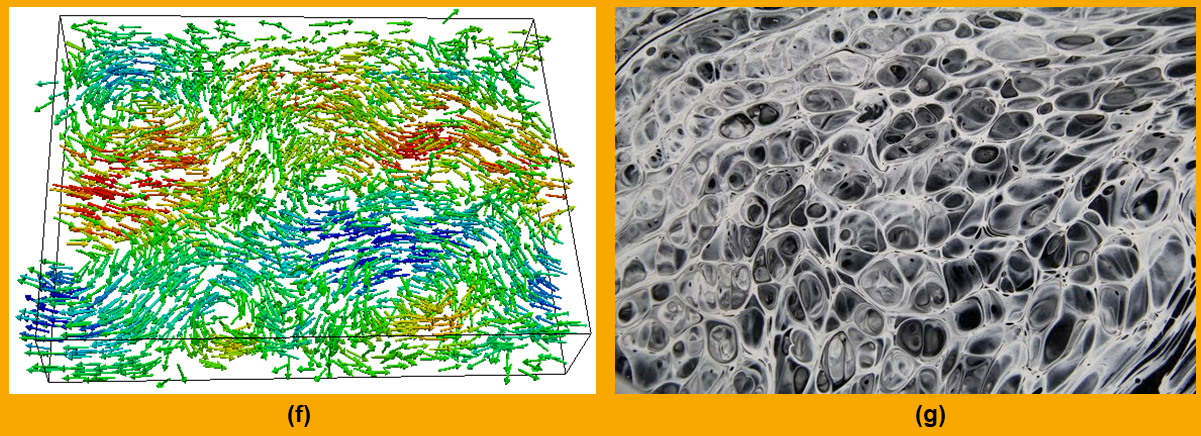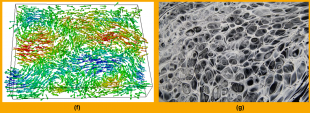Camille Duprat
École Polytechnique, Paris, France
Camille Duprat is Professor of Mechanics at École polytechnique, which she joined as assistant professor in 2013 after a PhD at Sorbonne Université and post-doctoral stays at Princeton University, USA and ESPCI, Paris. Her research focusses on fluid structure interactions at small scale, in particular in situations where fluid-fluid interfaces are important or in systems where viscous forces dominates. She is particularly interested in fiber-flow interactions, for example the transport of flexible fibers in viscous flows, or wetting and elastocapillarity in textiles.
Topic: Capturing drops with fibers: aerodynamics and capillary effects
We consider fibrous meshes placed in a flow of fog. This system, often encountered in aerosol filtration, exhibits a wealth of phenomena coupling aerodynamics and capillarity. In particular, we characterize experimentally and theoretically the flow through and around the porous mesh, the corresponding aerodynamic forces as well as the deposition of the mist droplets on the fibres, that all strongly depend on the mesh porosity and fine structure (i.e. the fibres’ arrangements). These droplets accumulate on the wire to form large drops exposed to a crossflow. For a range of Reynolds numbers, the wake of these drops is asymmetric, the drops spontaneously move along the fiber and interact aerodynamically with both with their downstream and upstream neighbors. Under a strong acceleration of the wind, the drops further interact with their unsteady wake and may eventually break up to be re-entrained by the flow.

Rama Govindarajan
International Centre for Theoretical Sciences, Tata Institute for Fundamental Research, Bengaluru, India
Rama Govindarajan is Professor and Dean at the International Centre for Theoretical Sciences, Tata Institute of Fundamental Research, Bengaluru, India. She did her PhD in Aerospace Engineering at the Indian Institute of Science, Bengaluru. Before joining TIFR she worked in the National Aerospace Laboratories and in the Jawaharlal Nehru Centre for Advanced Scientific Research, both in Bengaluru. She is a Fellow of the American Physical Society and of the Indian National Science Academy. She works primarily on particulate and droplet flows, flows with phase change and on instabilities.
Topic: A bifurcation and an instability in particulate flow
This talk is in two parts. (i) we talk about how heavy inertial particles, which are expected to merely centrifuge out of vortical regions and collect in strain regions in a flow, do something quite different in a rotating system. Particles collect near vortices, and can display fixed points and limit cycles in a period-doubling bifurcation. (ii) Saffman in 1962, assuming a constant viscosity flow, showed how particles in two-way coupling in a laminar shear flow can change its stability. We show how the change in viscosity due to particle concentration can bring down the instabulity-critical Reynolds number dramatically.
George Karapetsas
Department of Chemical Engineering, Aristotle University of Thessaloniki, Greece
George Karapetsas is an Associate Professor in the Department of Chemical Engineering at the Aristotle University of Thessaloniki (Greece). He obtained his PhD (2008) in Fluid Mechanics from the University of Patras (Greece) and then went to Imperial College London (UK) for postdoctoral research. He moved back to Greece in 2012 and successively joined as a Research Associate at the University of Thessaly, the National Technical University of Athens and the University of Patras. In 2018, he joined the faculty of the Aristotle University of Thessaloniki as an Assistant Professor. His research and teaching interests lie in the area of transport phenomena, fluid mechanics and applied mathematics. He is particularly interested in theoretical modelling and computations with special focus on interfacial and multiphase flows, phase-change, fluids with complex rheology, hydrodynamic stability, surface-tension-driven flows, wetting of complex surfaces, droplet dynamics, and fluid-structure interaction problems.
Topic: Unraveling the complex dynamics of wetting and phase change
Wetting of evaporating and condensing droplets is a common occurrence in nature, with significant implications for various industrial and everyday processes. Examples include painting, printing, oil recovery, pesticide applications, thermal management devices, DNA microarray analysis, and biological functions such as human perspiration. These systems typically involve complex liquids containing contaminants, particles, salts, or mixtures, interacting with micro-structured or soft substrates, and exhibiting a wide range of dynamic behaviors. In this talk, I will discuss our recent efforts to unravel the complexities within these multiphase systems, utilizing a combination of theoretical analysis, numerical simulations, and experiments.

Satish Kumar
Department of Chemical Engineering and Materials Science, University of Minnesota, USA
Satish Kumar is a Distinguished McKnight University Professor at the University of Minnesota where he is on the faculty of the Department of Chemical Engineering and Materials Science. Prof. Kumar received his undergraduate degree from Minnesota (1993), and his master's (1994) and doctoral degrees (1998) from Stanford University, all in chemical engineering. Following postdoctoral work at École Normale Supérieure (Paris) and the University of Michigan, he joined the faculty at Minnesota in 2001. Prof. Kumar currently serves as Faculty Director of the Industrial Partnership for Research in Interfacial and Materials Engineering (IPRIME), a university-industry consortium. He is both a Fellow and an Outstanding Referee of the American Physical Society, is Co-Editor-in-Chief of the Journal of Engineering Mathematics, and serves on the editorial board of the Journal of Non-Newtonian Fluid Mechanics. He has served as a member of the Executive Committee of the American Physical Society Division of Fluid Dynamics, and is a former president of the International Society of Coating Science and Technology. Prof. Kumar's research involves integration of transport phenomena, colloid and interface science, rheology, applied and computational mathematics, and experiments to address fundamental issues motivated by problems in materials processing. These fundamental investigations, which are described in over 150 journal articles and 27 PhD theses, are frequently inspired by industrial applications such as coating and printing processes, polymer processing, nanofluidics/microfluidics, and energy.
Topic: Nonuniformities in multilayer, multicomponent liquid-film coatings
Depositing and obtaining a liquid film of uniform thickness is a problem integral to numerous applications in the multibillion-dollar coatings industry. Film thickness is determined by the interplay of capillary leveling, Marangoni flows, evaporation, and various other phenomena. Applications often demand multilayer films where each layer has distinct properties, and this gives rise to additional challenges due to the presence of multiple components. This talk will provide an overview of these challenges and describe recent advances in our fundamental understanding of the physical mechanisms underlying film-thickness nonuniformities in multilayer, multicomponent liquid-film coatings.
Julia Yeomans
Physics, University of Oxford, UK
Julia Yeomans is Professor of Physics at the University of Oxford. She obtained her MA and DPhil in Physics from Oxford and then spent two years as a post-doc at Cornell University. She returned to the UK, as a Lecturer at the University of Southampton, before joining the Rudolf Peierls Centre for Theoretical Physics. Julia applies techniques from theoretical and computational physics to problems in soft condensed matter and biophysics. Her current research interests include active matter and mechanobiology. She has been awarded the EPJE-de Gennes Lecture Prize and the Sam Edwards prize of the Institute of Physics and she is a Fellow of the Royal Society.
Topic: Active Matter: “evading the decay to equilibrium”
Active systems such as bacteria, motor proteins and eukaryotic cells continuously transform chemical energy from their surroundings to mechanical work. Dense active matter shows mesoscale turbulence, the emergence of chaotic flow structures characterised by high vorticity and self-propelled topological defects. The theories of active matter are suggesting new ways of studying collective cell migration and remodelling which are important in early embryogenesis, wound healing, and biofilm formation.

Roberto Zenit
Engineering, Brown University, USA
Roberto Zenit received his Ph.D. from the Mechanical Engineering Department at Caltech in 1998. After a postdoctoral period at Cornell University, he moved to Mexico City in 2000 to become a faculty member at the Universidad Nacional Autónoma de México (UNAM), eventually becoming a Full Professor of Mechanical Engineering and a researcher at the Instituto de Investigaciones en Materiales, both at UNAM. He is now a Professor of Engineering at Brown University. He is a fellow of the APS, a member of the Mexican Academy of Sciences and the Academy of Engineering of Mexico. His area of expertise is fluid mechanics; he has worked in a wide variety of subjects including multiphase and granular flows, biological flows, rheology, and more recently, the physics of artistic painting.
Topic: Hydrodynamic instabilities as tools in artistic painting
Fluid mechanics is a subject that is relevant to every aspect of human activity. Art is not an exception. Artists, mostly painters but not exclusively, learn how to manipulate the material properties and the flow of liquids to produce textures, shapes and forms to create their objects of aesthetic value. As opposed to what is desired in industrial painting, where uniform and fast coatings are needed, artistic painting uses color gradients and non-uniform paint layers. In this talk, a survey of a few modern painting techniques will be discussed. Interestingly, in most cases, the appearance of non-uniformities is governed by hydrodynamic instabilities. Understanding how these instabilities emerge, and how can they be controlled, can be powerful tool understand art and to explore new avenues of artistic creation. Conducting research in this area is inspiring and engaging.






